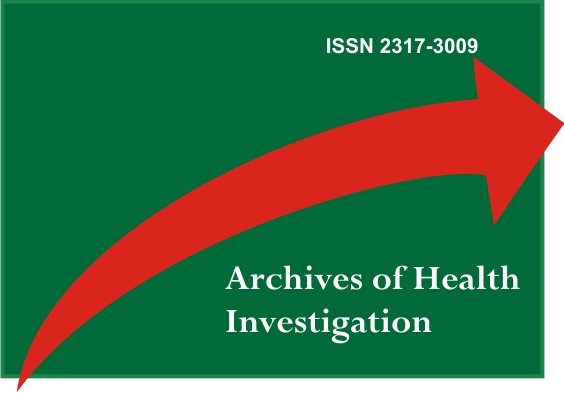Resina Infiltrante en el Tratamiento del Esmalte Hipoplásico: Reporte de Caso
DOI:
https://doi.org/10.21270/archi.v11i4.5446Palabras clave:
Infiltración Resinosa, Hipoplasia del Esmalte Dental, Odontología EstéticaResumen
Objetivo: este caso clínico tiene como objetivo describir el tratamiento clínico de la hipoplasia del esmalte en el diente 11, en una paciente de 23 años, utilizando un infiltrante resinoso. Caso clínico: brevemente, la lesión hipoplásica se trató con ácido clorhídrico al 15% durante 2 minutos. Luego, se aplicó alcohol al 99% a la lesión durante 30 segundos e infiltración de resina durante 3 minutos, seguido de fotopolimerización durante 40 segundos. De nuevo, la resina infiltrante se aplicó durante 1 minuto y se fotopolimerizó. Posteriormente, se realizó el acabado y pulido con cuencos de acabado y discos de pulido, seguido de disco de fieltro y pasta. Conclusión: se puede concluir que el protocolo utilizado en este reporte de caso demostró ser efectivo y produjo un excelente resultado estético.
Descargas
Citas
Muñoz MA, Arana-Gordillo LA, Gomes GM, Gomes OM, Bombarda NHC, Reis A, et al. Alternative esthetic management of fluorosis and hypoplasia stains: Blending effect obtained with resin infiltration techniques. J Esthet Restor Dent. 2013;25(1):32-9.
Sales MMS, Chisini LA, Castanheira VDS, Castro IS, Teixeira LS, Demarco FF. Non-fluorotic enamel defects in children: clinical and epidemiological aspects. Rev da Fac Odontol - UPF. 2016;21(2):251-59.
Auschill TM, Schmidt KE, Arweiler NB. Resin infiltration for aesthetic improvement of mild to moderate fluorosis: A six-month follow-up case report. Oral Health Prev Dent. 2015;13(4):317-22.
Son J-H, Hur B, Kim H-C, Park J-K. Management of white spots: resin infiltration technique and microabrasion. J Korean Acad Conserv Dent. 2011;36(1):66.
Todorova VI, Filipov IA, Khaliq AF, Verma P. Aesthetic Improvement of White Spot Fluorosis Lesions with Resin Infiltration. Folia Med (Plovdiv). 2020;62(1):208-13.
Tirlet G, Chabouis HF, Attal JP. Infiltration, a new therapy for masking enamel white spots: a 19-month follow-up case series. Eur J Esthet Dent. 2013;8(2):180-90.
Gugnani N, Pandit IK, Goyal V, Gugnani S, Sharma J, Dogra S. Esthetic improvement of white spot lesions and non-pitted fluorosis using resin infiltration technique: Series of four clinical cases. J Indian Soc Pedod Prev Dent. 2014;32(2):176-80.
Kabaktchieva R, Gateva N, Peycheva K, Dentistry DC. The role of light-induced fluorescence in the treatment of smooth surface carious lesions with icon infiltration and the result after 1 year. 2014;36-42.
Manoharan V, Kumar AS, Arumugam SB, Anand V, Krishnamoorthy, Santham Methippara JJ. Is Resin Infiltration a Microinvasive Approach to White Lesions of Calcified Tooth Structures?: A Systemic Review. Int J Clin Pediatr Dent. 2019;12(1):53-8.
Attal JP, Atlan A, Denis M, Vennat E, Tirlet G. White spots on enamel: Treatment protocol by superficial or deep infiltration (part 2). Int Orthod. 2014;12(1):1-31.
Cohen-Carneiro F, Pascareli AM, Christino MRC, Vale HF do, Pontes DG. Color stability of carious incipient lesions located in enamel and treated with resin infiltration or remineralization. Int J Paediatr Dent. 2014;24(4):277-85.
Paris S, Schwendicke F, Keltsch J, Dörfer C, Meyer-Lueckel H. Masking of white spot lesions by resin infiltration in vitro. J Dent. 2013 Nov 1;41(SUPPL.5):e28-34.
Phark J-H, Duarte Jr S, Meyer-Lueckel, Hendrik Paris S. Caries infiltration with resins: a novel treatment option for interproximal caries. Compend Contin Educ Dent. 2009;30(SpecNo 3):13-7.
Torres CRG, Borges AB, Torres LMS, Gomes IS, De Oliveira RS. Effect of caries infiltration technique and fluoride therapy on the colour masking of white spot lesions. J Dent. 2011;39(3):202-7.
Kidd EA, Fejerskov O. What constitutes dental caries? Histopathology of carious enamel and dentin related to the action of cariogenic biofilms. J Dent Res. 2004;83(Spec):C35-8.


